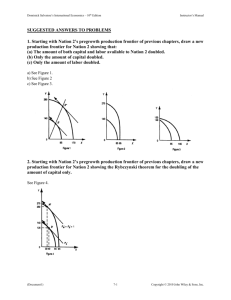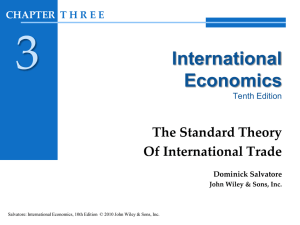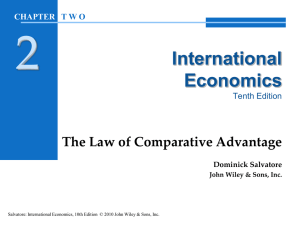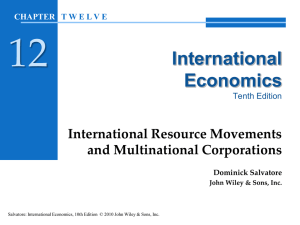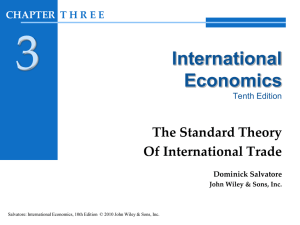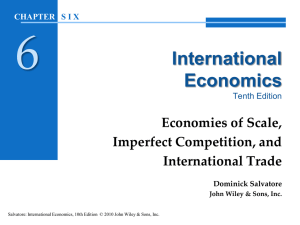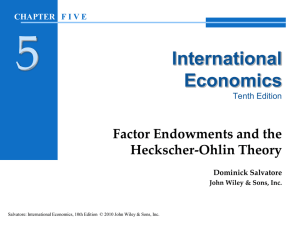Lecture notes
advertisement
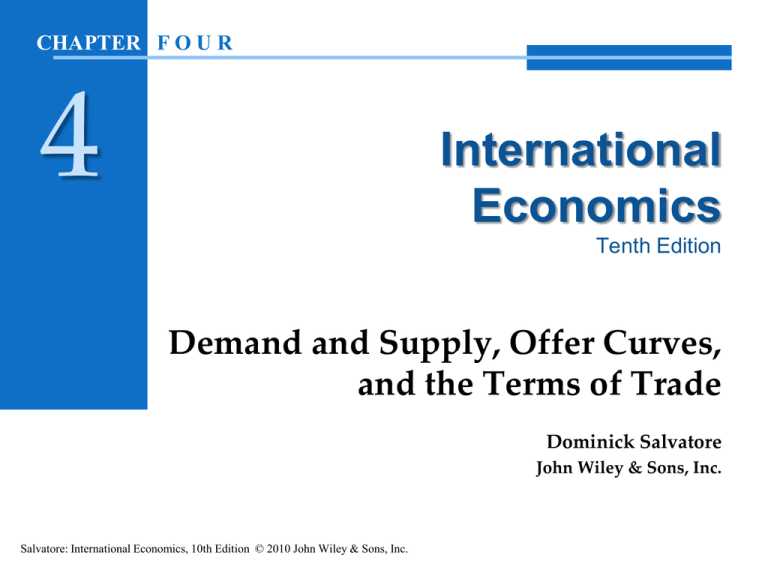
CHAPTER F O U R 4 International Economics Tenth Edition Demand and Supply, Offer Curves, and the Terms of Trade Dominick Salvatore John Wiley & Sons, Inc. Salvatore: International Economics, 10th Edition © 2010 John Wiley & Sons, Inc. In this chapter: Introduction The Equilibrium-Relative Commodity Price with Trade-Partial Equilibrium Analysis Offer Curves The Equilibrium-Relative Commodity Price with Trade-General Equilibrium Analysis Relationship between General and Partial Equilibrium Analysis Salvatore: International Economics, 10th Edition © 2010 John Wiley & Sons, Inc. Introduction Relative commodity price differences between two nations in isolation reflect comparative advantage, and forms basis for mutually beneficial trade. Can use partial and general equilibrium analysis to determine equilibrium-relative commodity price at which trade will take place. Salvatore: International Economics, 10th Edition © 2010 John Wiley & Sons, Inc. The Equilibrium-Relative Commodity Price with Trade-Partial Equilibrium Analysis See Figure 4-1 (next slide): At a relative price greater than P1, Nation 1’s excess supply of X (Panel A) gives rise to Nation 1’s international supply curve of X (S in Panel B). At a relative price lower than P3, Nation 2’s excess demand for X (Panel C) gives rise to Nation 2’s demand for imports of X (D in Panel B). Only at P2 (Panel B) does quantity of imports demanded equal quantity of exports supplied. Thus P2 is equilibrium-relative commodity price with trade. Salvatore: International Economics, 10th Edition © 2010 John Wiley & Sons, Inc. FIGURE 4-1 The Equilibrium-Relative Commodity Price with Trade with Partial Equilibrium Analysis. Salvatore: International Economics, 10th Edition © 2010 John Wiley & Sons, Inc. FIGURE 4-2 Index of Relative U.S. Export Prices (1995 = 100). Salvatore: International Economics, 10th Edition © 2010 John Wiley & Sons, Inc. Offer Curves Offer curves (sometimes called reciprocal demand curves) introduced to international economics by Marshall and Edgeworth. Shows how much of its import commodity a nation demands for it to be willing to supply various amounts of its export commodity. Can be derived from production possibilities frontier, indifference map and various hypothetical relative commodity prices at which trade could take place. Salvatore: International Economics, 10th Edition © 2010 John Wiley & Sons, Inc. FIGURE 4-3 Derivation of the Offer Curve of Nation 1. Salvatore: International Economics, 10th Edition © 2010 John Wiley & Sons, Inc. FIGURE 4-4 Derivation of the Offer Curve of Nation 2. Salvatore: International Economics, 10th Edition © 2010 John Wiley & Sons, Inc. The Equilibrium-Relative Commodity Price with Trade-General Equilibrium Analysis Equilibrium-relative commodity price with trade found at intersection of offer curves for two nations. Only at this equilibrium price will trade be balanced. At any other relative commodity price, quantities of imports do not equal quantities of exports, placing pressure on relative commodity price to move toward equilibrium. Salvatore: International Economics, 10th Edition © 2010 John Wiley & Sons, Inc. FIGURE 4-5 Equilibrium-Relative Commodity Price with Trade. Salvatore: International Economics, 10th Edition © 2010 John Wiley & Sons, Inc. Relationship between General and Partial Equilibrium Analyses Both partial equilibrium and general equilibrium analysis use production frontiers and indifference maps to find equilibrium trade price. Only general equilibrium analysis considers all markets together, not just the market for commodity X. Changes in the market for X affect other markets, which possibly impact the market for X. General equilibrium analysis is therefore required for more complete analysis. Salvatore: International Economics, 10th Edition © 2010 John Wiley & Sons, Inc. FIGURE 4-6 Equilibrium-Relative Commodity Price with Partial Equilibrium Analysis. Salvatore: International Economics, 10th Edition © 2010 John Wiley & Sons, Inc. The Terms of Trade Terms of trade = the ratio of the price of a nation’s export commodity to the price of its import commodity. In a two-nation world, the terms of trade of Nation 1 are equal to the reciprocal of the terms of trade of Nation 2. In a world of many traded goods, the terms of trade is the ratio of the export price index to the import price index, also called commodity or net barter terms of trade. If Nation 1 exports X and imports Y, its terms of trade are given by PX/PY, where P = price index. Salvatore: International Economics, 10th Edition © 2010 John Wiley & Sons, Inc. Appendix to Chapter 4 Derivation of a Trade Indifference Curve for Nation 1 Derivation of Nation 1’s Trade Indifference Map Formal Derivation of Nation 1’s Offer Curve Outline of the Formal Derivation of Nation 2’s Offer Curve Meade’s General Equilibrium Trade Model Stable and Unstable Equilibria Salvatore: International Economics, 10th Edition © 2010 John Wiley & Sons, Inc. FIGURE 4-7 Derivation of a Trade Indifference Curve for Nation 1. Salvatore: International Economics, 10th Edition © 2010 John Wiley & Sons, Inc. FIGURE 4-8 Derivation of Nation 1’s Trade Indifference Map. Salvatore: International Economics, 10th Edition © 2010 John Wiley & Sons, Inc. FIGURE 4-9 Formal Derivation of Nation 1’s Offer Curve. Salvatore: International Economics, 10th Edition © 2010 John Wiley & Sons, Inc. FIGURE 4-10 Outline of the Formal Derivation of Nation 2’s Offer Curve. Salvatore: International Economics, 10th Edition © 2010 John Wiley & Sons, Inc. FIGURE 4-11 Meade’s General Equilibrium Trade Model. Salvatore: International Economics, 10th Edition © 2010 John Wiley & Sons, Inc. FIGURE 4-12 Stable and Unstable Equilibria. Salvatore: International Economics, 10th Edition © 2010 John Wiley & Sons, Inc.
